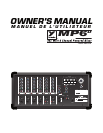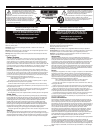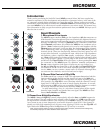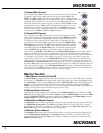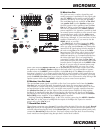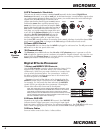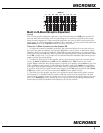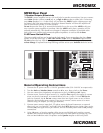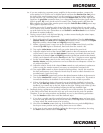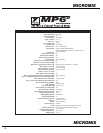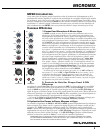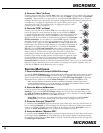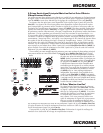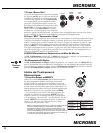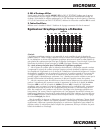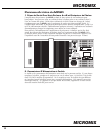
MICROMIX
MICROMIX
3
5. Main Line Out
This jack can serve a variety of patching and
routing purposes. It positioned in the signal path
after the MP6D's main graphic equalizer and is
therefore affected by it (i.e. they are post-EQ).
The main bus signals are available at line level
(not speaker level; use the Speaker outputs on
the back panel to drive speakers) from the Line
Out jack. Taking a signal from this jack has no
effect on the operation of the MP6D's built-in
power amplifiers. It is, therefore, possible to feed
an external power amplifier or even several inter-
connected power amps, with the Main output
signal, while the internal power amplifier is also
functioning (although, it is not necessary to have
speakers connected e.g. if you want to use the
MP6D strictly as a mixer).
The Line In jack is a direct input to the built-
in power amplifier. This is a switching jack, and
when you plug into the Line In, you interrupt the
internal flow of signals going from the outputs of
the main mixing bus to the inputs of the built-
in power amp. This allows you to insert a signal
control device such as a speaker processor, an
additional equalizer, or a compressor/limiter into
the Main signal path. This is accomplished by
connecting a patch cable from the Line Out jack
to the device's input jack and another patch cable
from the device's output jack to the MP6D's Line
In jack. If you are using an external power amp
for the main PA speakers, you may run a short
patch cable from the Monitor Line Out jack to the Line In jack and simply connect your moni-
tor speakers to the MP6D's Speaker outputs on the back panel. It is even possible to connect
another mixer to the MP6D's power amplifier via the Line In jack. This slaves the amplifier to
that mixer's signals (i.e. it no longer receives the built-in mixer's signals), which means that you
could use the built-in mixer to do another, totally separate, mixing job. For example, you could
patch the MP6D's Line Out signal to an input on another mixer connected to amps driving a PA
speaker system while using the MP6D's amplifier to power control room speakers.
6. Monitor Line Out Jack
The monitor bus output signal is available at line level (not speaker level) from the Monitor
Line Out jack and would normally be patched to the input of a mono power amplifier, or
one channel of a stereo amp driving monitor speakers. Keeping in mind that there is no inter-
nal equalization for the monitor mix, you might want to patch a graphic equalizer between
the Monitor Line Out jack and the input of your monitor power amplifier to help regulate
feedback. As mentioned under the previous section, the monitor mix signal can alternately
be patched to the internal amplifiers via the Line In jack. Ask your dealer about the Yorkville
Beta-150EQ power amplifier, it has a built-in graphic equalizer.
Patching something between things, in this case, means connecting the MP6D's Monitor
Line Out jack to the input of an EQ and the output of the EQ to the input of a monitor
power amp or the Line In jack.
7. Record Out Jacks
These phono connectors carry the pre-EQ (not affected by the Main EQ) main mix signals. Record
Out signal levels are not regulated by the Main master. This allows the level to the speakers to be
reduced without lowering the levels to the Record Out jacks. Using phono-to-phono patch cords,
connect the Record Out jacks to the Aux. (line-level) inputs on the tape deck. Actual recording
levels would now be adjusted using the tape deck's record level control/s.
63
12
6
0
6
12
12
6
0
6
12
125 250 500 1.0K 2.0K 4.0K 8.0K 16K
5
6
10
4
0
73
19
82
5
6
10
4
0
73
19
82
6
10
4
0
73
19
82
5
5
6
10
4
0
73
19
82
MONITOR
MASTER
PHANTOM
POWER
LINE OUT
LINE IN
MAINS
MONITOR
LINE OUT
RECORD
OUT
FOOTSWITCH
/ SEND
POWER
MONITOR EFX
MAIN EQ
MAIN EFX
MAIN MASTER
CLIP CLIP
EFX
MP6
D
SERIES 2
CLIP
EFX
Modify
+
-
Room Reverb
Hall Reverb
Hall Reverb - Vocals
Hall Reverb w/Echo
Plate Reverb
Plate Reverb - Vocals
Plate Reverb w/Echo
Gated Reverb
decay
decay
decay
decay
decay
gain
pitch
delay
rate
1.
2.
3.
4.
5.
6.
7.
8.
9.
10.
11.
12.
13.
14.
15.
16.
Fast Echo
Short Decay Echo
Long Decay Echo
Chorus
Flanger
Rotary Speaker
Distortion
Harmonizer
ModifyEffect ModifyEffect
M
O
D
U
L
A
T
I
O
N
G
A
T
E
H
A
R
D
I
S
T
P
L
A
T
E
S
E
C
H
O
H
A
L
L
S
16
1
15
214
313
412
511
610
79
8
R
O
O
M
24



